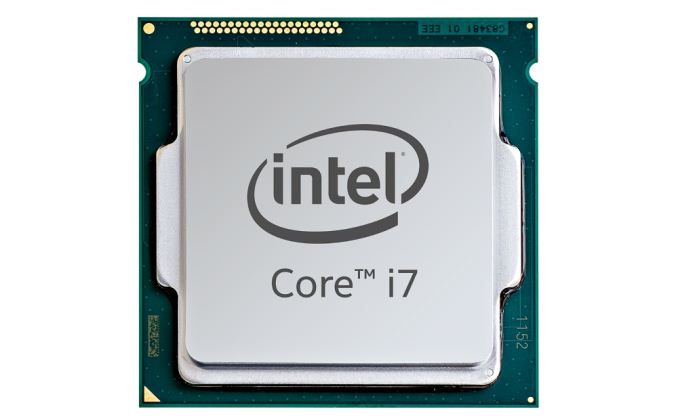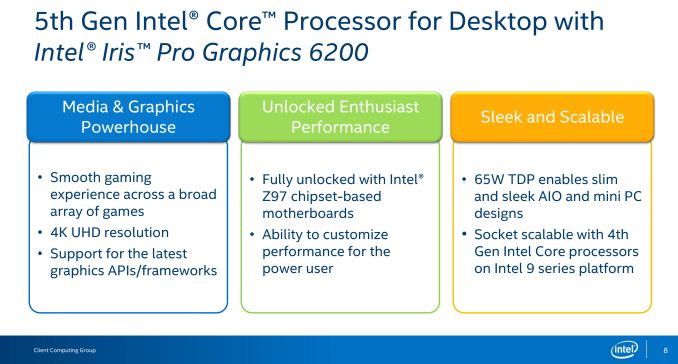The Intel Broadwell Desktop Review: Core i7-5775C and Core i5-5675C Tested (Part 1)
by Ian Cutress on June 2, 2015 7:45 AM ESTBroadwell-DT: Initial Thoughts
The new Broadwell desktop processors are somewhat out of sync with our regular expectations from Intel. Due to issues surrounding the 14nm node, as well as the cost, the whole Broadwell line from tablet to table-top has come out slower and more staggered than any Intel release in recent memory. As a result, the initial launch from Intel today is a pair of 65W desktop socketed models backed up with three 65W soldered down models whose true heritage is a chip primarily designed for large laptops and all-in-one devices.
Normally we would expect a range of desktop models from 35W up to 88W or higher, but socketed Broadwell-DT today only exhibits two units at 65W. This immediately puts a slight damper on those expecting to upgrade from Haswell’s high-end, or those wanting to go from something like a Pentium G3258 on Haswell to Broadwell’s top SKU. As a result, we have to keep our expectations in check – 65W should on paper perform nearly as well as an 88W part would, except it would be reduced by several hundred MHz. Meanwhile as these processors are also fully-unlocked and overclockable, we're left to ponder whether or not the stock frequencies actually matter in that case.
Due to the differential tangent at play, these processors also exhibit Intel’s best integrated graphics package, Iris Pro (GT3e), previously reserved only for soldered down/laptop/mini-PC orientations. This graphics package comes with largest number of execution units available from Intel, 48, alongside 128MB of eDRAM that acts almost like an L4 cache. This helps alleviate memory bandwidth pressure by providing a large(ish) pool near the CPU but with lower latency and much greater bandwidth than main memory. The eDRAM has the greatest effect in graphics, but we also saw some moderate increases in our non-3D regular benchmark suite.
The benefit of the graphics package, Iris Pro 6200, means that Broadwell-DT takes the crown as the fastest socketed graphics available. Our testing showed that the even the second-tier socketed SKU, the i5-5675C, outgunned the previous title holder, AMD’s A10-7870K. Despite having the i7-5775C in to test, due to time and firmware issues, we were unable to run the numbers on the integrated graphics but will do so in a later piece.
The key element to Broadwell-DT is not to consider it a natural successor to Haswell. It doesn't so much replace Haswell-K at this time, so much as it occupies a space Intel has left neglected since the launch of Haswell – the ultimate Intel integrated graphics solution. For users on integrated graphics, where money is no object, Intel now offers you the option to combine the regular CPU performance associated with Intel and a GPU that has the added performance benefits of on-chip, high-bandwidth eDRAM. The only question is whether that combined performance is worth the potential cost, and some would say no, pointing at a combined APU + GPU solution for equivalent or better gaming performance for the same price.
Pricing for the i5-5675C is listed as $276, slightly higher than the price of the i5-4690K which is at $236 on Amazon (reduced from $265). The i7-5775C is a bit higher at $366, also a margin higher than the i7-4790K which is $339 (reduced from $380). This makes Broadwell a tough sell right now in most circumstances unless you are absolutely limited to integrated graphics and want the best solution possible in a configurable PC. Given that Intel has also mentioned Skylake in their recent Computex keynote, it implements an abnormal situation that Intel has never been in with a new platform being talked about in the same breath. We have been told that these parts exist because users wanted them, and it has been interesting to see just how the added eDRAM changes the performance with discrete graphics in the mix.












196 Comments
View All Comments
Pcorb - Tuesday, June 2, 2015 - link
I'm not so sure that high end desktop users are a large enough demographic that Intel will be complaining any time soon.yannigr2 - Wednesday, June 3, 2015 - link
Yes I am shouting that for a month now, but of course I was treated as an AMD brainless fanboy when pointing at that, so I must be wrong. Now we have a chart that it is misleading and hilarious at the same time. If Ian had done what is right and logical, those charts would have been informative, correct and fair. I think AMD created 7870K just to troll Ian's charts.Hulk - Tuesday, June 2, 2015 - link
It would be really nice if you would note the frequency each processor is running during each test. With all the turbos these days it's hard to know and therefore hard to make IPC comparisons.Mr Perfect - Tuesday, June 2, 2015 - link
Yes, please. Once upon a time, I would have had the clocks for all the models memorized, but without that comparing IPC is difficult to impossible without the clocks noted.MrSpadge - Tuesday, June 2, 2015 - link
+1Lonyo - Tuesday, June 2, 2015 - link
You state in the opening that if you upgrade on a 3 year cycle, you would be coming from SandyBridge. Would it not make sense to have some older Intel processors in the graphs?Ian Cutress - Tuesday, June 2, 2015 - link
With a recent new testing suite, we haven't gone back through enough generations yet with the new benchmarking scheme. You can still check legacy benchmarks (Cinebench 10 / POV-Ray) between old and new in Bench. www.anandtech.com/benchHulk - Tuesday, June 2, 2015 - link
Yes. One thing Anand did amazingly well was review the new Intel processors. Clock-normalized IPC comparisons from previous generations is really what we want to see. As well as normalized power consumption, ie energy used completing the same workload.mgilbert - Tuesday, June 2, 2015 - link
As a normal home PC user/gamer, I couldn't care less about small differences in power consumption. Sure, 100 Watts might matter, but what matters most to me is outright performance.Martin84a - Tuesday, June 2, 2015 - link
As a normal PC user/gamer, that's all I care about. Less heat and thus less noise. Having a passively cooled PC that never goes above 65C under load is pure bliss.